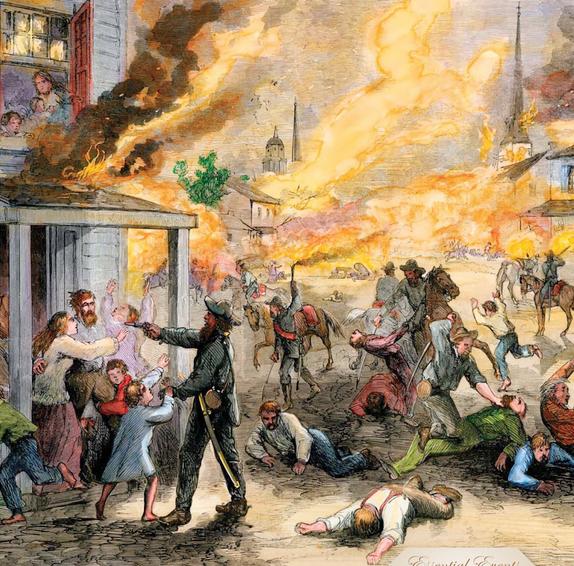
American Civil War: Quantrill Raid on Lawrence, Kansas (1863)

Figure 1.-- There were no Civil War battles of any importance fought in Kansas. There were some 30 Confederate raids into Kansas. The most serious raid was an attack on Lawrence, Kansas by a partisan force led by Major William Clarke Quantrill (August 21, 1863). It was the most infnous partisn attack of the War. They burned most of the town to the ground and killed 164 men and boys. Quantrill also jutified his action for what he described as the 'citadel of abolition' would revenge the wrongs, real or imagined that the Southerners had suffered at the hands of Jayhawkers.
|
|
Thomas Ewing Jr. (1829–96) was an attorney, the first chief justice of Kansas and leading free state advocate. During the Civil War he was given command of the District of the Border, which comprised Kansas and western Missouri with the rank of Brigadier General Thomas Ewing, Jr. had ordered the jailing of women who were providing aid to Confederate partisans. The delapidated jail's roof collapsed, killing five of the imprisoned women. Missouri was a slave border state that stayed in the Union. There was, however, support for the Condederacy and partisan groups formed after General John C. Frémont held Missouri for the Union. Missori was the most northern slave state. The further loss of Kentucky and Federal control of the Mississippi helped isolate Missouri from the Confederacy. The Federals drove regular Confederate units from the state. The partisans in Missouri were enfuriated when they learned what had happened. in Lawrence Quantrill and his men raided Lawrence. They burned most of the town to the ground and killed 164 men and boys. Quantrill also jutified his action for what he described as the 'citadel of abolition' would revenge the wrongs, real or imagined that the Southerners had suffered at the hands of Jayhawkers. The Confederate government, which had granted Quantrill a field commission under the Partisan Ranger Act, was outraged and withdrew support for such irregular forces. Quantrill's force included the youthful Jesse James and his older brother Frank. Quantrill is often seen as influencing Wild West banditry, outlaws and hired guns. Quantrill was mortally wounded by Union troops in central Kentucky, one of the last engagements of the Civil War (May 1865). Had he not been killed, he probably would have been tried and hung as a war criminal. Ewing in resonse to the Quantrill raid issued the draconian General Order No. 11.
CIH -- Civil War

Navigate the Boys' Historical Clothing Web Site:
[Return to Main Bleeding Kansas page]
[Return to Main American debate on slavery page]
[About Us]
[Biographies]
[Campaign]
[Causes]
[Emancipation]
[Families and youth]
[Fiscal policy]
[Formations and units]
[Law]
[Railroads]
[Reconstruction]
[Slavery]
[Soldiers]
[Uniforms]
[Weaponry]
[Return to the Main Civil War page]
[Lost Cause]
[Segregation]
[Civil Rights movement]
[Return to CIH Home page]
Created: 8:04 PM 12/15/2018
Last updated: 8:04 PM 12/15/2018



